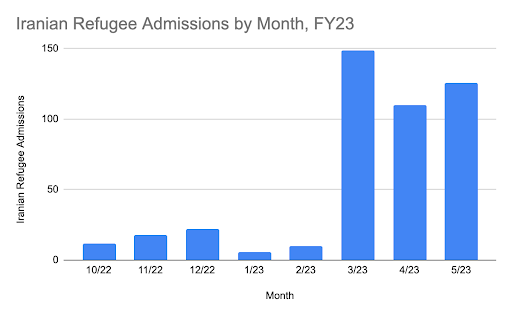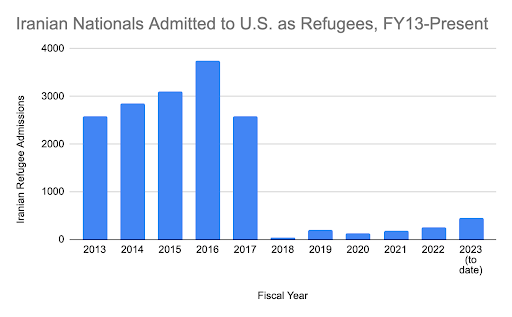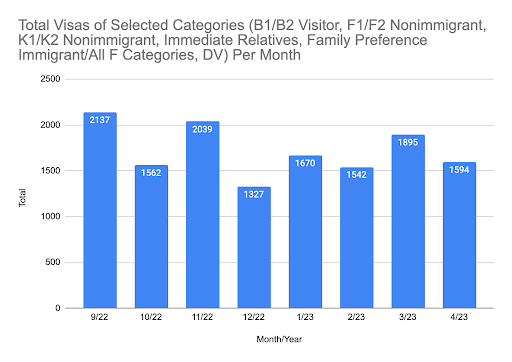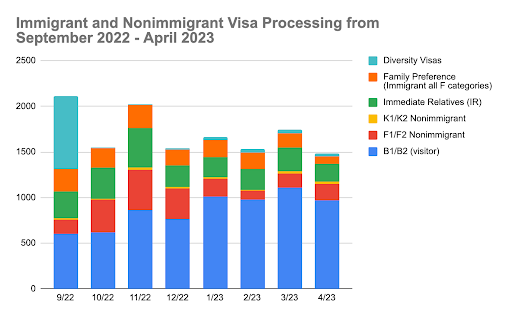One of the National Iranian American Council’s primary recommendations to the Biden administration following the outbreak of nationwide protests in Iran in September 2022 was to increase visa and refugee processing for Iranians who need to get to safety.
Several months after the outbreak of protests and our recommendation, visa and refugee data indicates that the Biden administration has made some improvements in processing Iranians. However, the scale of improvement – with visa processing still lagging far beyond historical numbers that preceded the Muslim ban and COVID-19 pandemic – still leaves much to be desired. This is an area of focus that must be intensified for the Biden administration.
Refugee Processing

Between October and February there was no improvement in processing Iranians as refugees, with an average of only 15 Iranians admitted as refugees per month. However, the Biden administration appears to have spurred into action in the months that followed, averaging 128 Iranian refugees admitted per month between March and May. This apparent decision to increase refugee processing for Iranians led to 340 more Iranians being admitted as refugees than would otherwise have been admitted, making a significant difference in their lives.
Projecting this new average out over the course of an entire year would mean that 1,360 Iranians would be admitted as refugees into the United States by March 2024, far surpassing the paltry refugee admissions for Iranians that have followed the Trump administration’s gutting of visa and refugee processing. Across all of Fiscal Year 2018, the Trump administration admitted just 51 Iranian refugees. These numbers increased slightly in the years that followed, hovering below 200 total refugee admissions during the Trump years and only crossing that threshold to 255 total Iranian refugee admissions in Fiscal Year 2022 under the Biden administration.

However, 1,360 Iranian refugees would still be a small number compared with what occurred under the Obama administration. In Fiscal Year 2013, the Obama administration processed 2,578 Iranians – nearly double the pace of processing today. The Obama administration increased processing in each subsequent year, processing 3,750 Iranians as refugees in Fiscal Year 2016. The total number of Iranian refugees admitted in a single month of Fiscal Year 2016 easily surpasses the total admitted in any fiscal year between 2018 and 2022. Given the scale of the human rights and economic crises afflicting Iranian society today, this is a pace that the Biden administration should strive for over the course of the next year.
Broader Visa Processing


The picture for other visa categories is less straightforward, but there does not appear to be a significant jump that isn’t explained by broader trends. Visitor visa (B1/B2) processing has increased significantly following the protests, though this appears to be related to improvements in visitor visa processing across the board. The last six months of FY22 saw an average of 509 visitor visas issued to Iranians, whereas the seven months we have available for FY23 saw a jump of 77% to a monthly average of 900 visitor visas issued. This upward trend should continue.
Both student visas and diversity visa issuance to Iranians saw declines between the latter six months of FY22 and the first seven months of FY23 of 46% and 92% respectively. While disappointing, these are visa categories where monthly issuances fluctuate significantly, with the State Department processing the majority of its visas for Iranian students in the summer and for Diversity Visa recipients in the deadline before the conclusion of the Fiscal Year. We strongly encourage the State Department to accelerate its processing in these categories in the months that follow, each of which offer life-changing opportunities for those lucky enough to receive them.
Processing of family preference visas and immediate relative visas largely continued in line with preceding months. Family preference immigrant visas saw a marginal increase of 2.7%, while immediate relative visas saw a marginal decline of 6.4%, in the opening months of FY23. Immediate relative visas processing saw a concerning decline in processing in recent months, which we hope will be reversed.
More Processing Needed
The Biden administration is deep into its third year in office and can no longer blame poor visa processing and refugee processing for Iranians on the last administration and its policies like the Muslim Ban. While recent data on refugee processing is welcome, particularly for those who have benefited, the broader trend lines are not encouraging. It does not appear that the Biden administration has made this a major priority, as processing numbers do not even come close to what was achieved in the Obama administration in any category. Likewise, proposals such as adopting humanitarian parole for Iranians – put forward by Senate Foreign Relations Committee Chair Bob Menendez – have not been adopted and may have been ruled out entirely. As the need for getting Iranians outside the country and to the United States has increased, the Biden administration must meet the urgency of the moment and increase its processing in the months to come.
Back to top